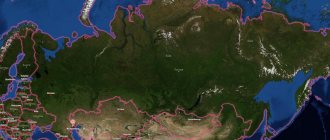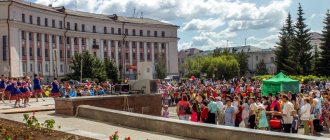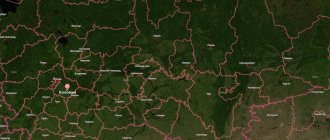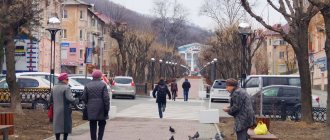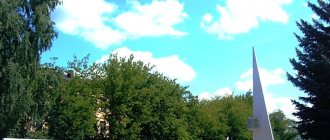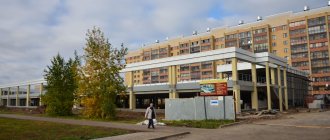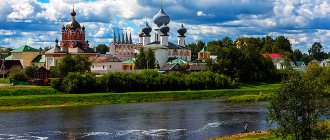Vladimir is a city in Russia, the administrative center of the Vladimir region. One of the oldest cities in Russia with a very rich history, which is a popular tourist destination in the northeast of the European part of Russia:
- 9-10 centuries - the first Slavs begin to settle on the banks of the Klyazma River;
- 1108 - foundation of the fortress of the same name by Vladimir Monomakh, which quickly turned into a city;
- 1157 - the city of Vladimir becomes the capital of the Vladimir Principality;
- 1138 and 1293 - Vladimir is attacked by the Mongol-Tatars;
- 1299 – transformation of Vladimir into the capital of “all Rus'”;
- 1491 - creation of city fortifications;
- 1609 – 1614 – raids by Polish-Lithuanian troops;
- 1778 - the emergence of the Vladimir province;
- 1920-1950 – increased industrialization of the city.
- 1960 - construction of a bridge across the Klyazma River.
The population of the city is 356 thousand people. The ethnic composition of Vladimir is quite homogeneous: Russians 95%, Ukrainians 1%, Tatars and Belarusians 0.5% each, the rest 3%.
Where is Vladimir?
Convenient location, proximity to the capital and other regional centers are attractive characteristics, thanks to which the number of tourists coming to the city is constantly increasing. Where is the city of Vladimir: in the central part of Russia on the banks of the Klyazma River, which is the left tributary of the Oka.
The settlement is located 180 km east of Moscow. You can get to it by following the M-7 Volga highway, or by rail in the direction Moscow - Nizhny Novgorod.
VLADIMIR
VLADIMIR, a city in Russia, the administrative center of the Vladimir region, forms the urban district of the same name. Population 356.9 thousand people. (2019; 345.4 thousand people in 2010, 316.0 thousand people in 2002, 349.7 thousand people in 1989, 296.4 thousand people in 1979, 234.1 thousand people. in 1970, 153.9 thousand people in 1959). Located in the central part of the East European Plain, on the border of the Vladimir Opolye and the Meshchera Lowland, on the Klyazma River. The Volga highway passes through Vladimir (Moscow - Nizhny Novgorod - Kazan - Ufa); The city is connected by highways with Murom, Ryazan, Yaroslavl and Ivanovo. Junction railway station on the Moscow – Nizhny Novgorod line, with a branch to Gus-Khrustalny. Domestic airport "Semyazino". Main gas pipeline Urengoy – Nizhnyaya Tura – Perm – Izhevsk – Kazan – Nizhny Novgorod – Vladimir – Sergiev Posad.
Story
On the territory of modern Vladimir, a settlement (presumably) of the early Iron Age, Meri settlements (8th–10th centuries), and Old Russian settlements (from the 11th century) are known. The city of Vladimir was founded ca. 1108 Pereyaslavl Prince Vladimir Vsevolodovich Monomakh. In 1157, Prince Andrei Yuryevich Bogolyubsky moved the center of the Rostov-Suzdal Principality to Vladimir, which led to the formation of the Grand Duchy of Vladimir. Vladimir reached its peak in the 2nd half of the 12th century. In 1185 it was severely damaged by fire and almost rebuilt. In the 12th–14th centuries. major center of chronicle writing.
Vladimir. Golden Gate. 1158–64, 17th–18th centuries
Vladimir. Assumption Cathedral. 1158–60, 1185–89. Photo by A. I. Nagaev
Old Russian settlements and the city were located on the cape of the Klyazma and Lybid rivers. By the middle of the 12th century. A system of wood-earth fortifications of Vladimir (preserved in fragments), surrounded by ditches, was formed, and at the same time its three-part urban structure was formed (area approximately 120 hectares; included the “Monomakhov”, or Middle, city, New city, Posad, or Vetchany city). To the city with the Detinets, which had tuff walls, white stone gates with the gate church of Joachim and Anna (1196), decorated with a carved portal, glazed tiles and a gilded copper roof. The Assumption Cathedral (1158–60, 1185–89; paintings by Andrei Rublev and Daniil Cherny, 1408) and the Demetrius Cathedral (1193–97?) were located in Dytinets. On the eastern (floor) side, the “Monomakhov” city was adjoined and connected to it through the Trade Gate by the New City, where the white-stone Golden Gate was also erected (1158–64, rebuilt in the 17th–18th centuries, white-stone arch with a tuff vault and extensions ; above it is the gate church, renewed in 1469 by V. D. Ermolin, rebuilt in 1810) and the wooden Irinin Gate. The settlement, located to the west of the “Monomakhov” city, was connected to it by the Silver Gate. In various parts of Vladimir, log-frame above-ground and half-dugout dwellings, mainly with adobe stoves, various outbuildings, palisades dividing the estates, etc., were examined.
In 1238, the city was burned during the Mongol-Tatar invasion (this event is associated with a number of discovered treasures of precious items hidden during the approach of the enemy and during the siege of Vladimir - unique sources for the study of ancient Russian culture). Subsequently, he quickly rebuilt. Despite the devastation during the Horde raids of the 13th–15th centuries. (1293, 1382, 1410), remained one of the largest Russian cities (a building in the 2nd half of the 13th–14th centuries was studied near the Demetrius Cathedral, where stained glass, numerous items imported from Eastern countries, and artistic bronze items were found). In 1299–1328 Vladimir was the residence of Russian metropolitans. Gradually towards the middle - 2nd half of the 14th century. the city ceded its role as an all-Russian political center to Moscow, while retaining its economic and commercial importance. Destroyed during the intervention of the Polish-Lithuanian Commonwealth in the early 17th century. (in 1613 there were about 600 inhabitants left in Vladimir). The advantageous position on the trade route from Moscow to Nizhny Novgorod contributed to the revival of Vladimir and the development of trade in it. The carriage trade was widespread (until the mid-19th century). From 1719 the center of the Vladimir province of the Moscow province, in 1778–1929 the center of the Vladimir province (until 1796 - the Vladimir governorship). “Vladimirka” passed through Vladimir - the road along which exiles went from Moscow to Siberia. At the end of the 18th century. the Vladimir Central was founded (before the October Revolution of 1917 - a transit prison; in the 20th century, M. V. Frunze, L. A. Ruslanova, the son of I. V. Stalin - V. I. Stalin, D. L. Andreev and etc.; in 1996 a museum was created at the prison, opened in 1997). In 1862, traffic began on the Moscow-Nizhny Novgorod railway, passing through Vladimir. In Oct. / Nov. 1917 owl was installed in the city. power. In 1929–36 the regional center of the Ivanovo Industrial Region, in 1936–44 of the Ivanovo Region, from 1944 the administrative center of the Vladimir Region. Since 2004, the center of the city district of the same name.
Architecture
Large stone construction in Vladimir took place in the 2nd half of the 12th century, when the Vladimir-Suzdal school emerged in Russian architecture. The white stone architectural monuments of Vladimir are included in the World Heritage List. At the beginning of the 16th century. In the traditions of Moscow architecture, the Assumption Cathedral of the Princess Monastery was erected (paintings with the composition “The Last Judgment”, 1647–48, artist Mark Matveev and others). The Assumption Church (1644–49) was built in the forms of townsman architecture. The traditional type of “octagon on a quadrangle” includes the churches of St. Nicholas in Galei (1732–35), Trinity (1740), distinguished by their slenderness and exquisite decor. Baroque monuments - the Bishop's Chambers of the Nativity Monastery (1748), the Church of St. Nikita the Martyr (1762–65), the iconostasis of the Assumption Cathedral (1768–74). The churches of St. George (1784–96) and Nikolo-Kremlevskaya (1769) have Baroque decor. According to the regular plan of 1781 (implemented with significant adjustments), a three-part urban structure was preserved with a main street common to all three parts; each of them received a rectangular grid of streets, which were built up with houses according to exemplary designs (partially preserved). The Churches of the Presentation (1807) and Prince Vladimirskaya (1785) were built in the style of early classicism. The main works of classicism are Public places (1785–90, presumably architect K. I. Blank), Shopping arcades (1787–93, architects N. P. von Berk, A. I. Chistyakov), the complex of the Noble Assembly and the men's gymnasium (1825 –27, 1837–41, architects V. A. Dregalov, E. Ya. Petrov), governor’s house (1787). The combination of elements of classicism and neo-Gothic is characteristic of the bell tower of the Assumption Cathedral (1810). Buildings in the neo-Russian style - the City Duma (1907, architect Ya. G. Revyakin), the building of the Historical Museum (1900–06, architect P. G. Begen), the Church of St. Michael the Archangel (1891–93, architect A. P. Afanasyev) and Trinity (1913–16, architect S. M. Zharov), Red Cross Hospital (1914–16, architect L. M. Scherer). Neo-Gothic church (1891, architect I. A. Karabutov). The People's House of the Temperance Society (1904–05, 1907, architects Revyakin, Begen) and the Real School (1907–08, architect P. A. Vinogradov) are in the Art Nouveau style. Neoclassical cinema "Empire" (1913, architect Zharov); Among the buildings of the post-war period is the Palace of Culture (1954). The building of the Drama Theater (1970; architect G. P. Gorlyshkov). Monuments: 850th anniversary of Vladimir (1960, sculptor D. B. Ryabichev, architect A. N. Dushkin), Alexander Nevsky (1963, sculptor S. M. Orlov), Andrei Rublev (1995, sculptor O. K. Komov), 2000th anniversary of the Nativity of Christ (author M. I. Gelvanovsky, blacksmith Yu. A. Zimin), etc.
Centers of science and culture
Universities: State University named after. A. G. and N. G. Stoletov (founded in 1958 as a branch of the Moscow Evening Engineering Institute, current status since 1996; in 2011 it included the State Humanitarian University, founded in 1919); institutes: business (1991), legal FSIN of Russia (history dates back to 1943, current status since 1996), tourism and hospitality (2007).
Libraries: regional scientific named after. M. Gorky (1897), central city (1946), for children and youth (2011), etc.
State Archive of the Vladimir Region (history dates back to 1918, current status 1922–29 and 1944; in 1929–44 as part of the Ivanovo Regional Archive).
Vladimir-Suzdal Historical, Art and Architectural Museum-Reserve (1854, modern name since 1958; includes exhibitions and interiors of the Assumption and Dmitrievsky Cathedrals, a historical museum, a military-historical exhibition in the Golden Gate, the "Old Vladimir" museum in a former water tower, an exhibition “Crystal, lacquer miniature, embroidery” in the Old Believer Trinity Church, Stoletov House-Museum, Museum of Nature). Other museums: Vladimirsky, gingerbread, fairytale museum “Granny-Yagusya”. Art gallery (1995; in the building of former government offices; Russian art of the 18th – early 20th centuries). Exhibition Center (2011).
Theatres: academic regional drama named after A.V. Lunacharsky (1848), puppet theater (1969), municipal folklore theater “Razgulay” (1993).
Philharmonic Society (1944), consisting of: State Vocal and Choreographic Ensemble “Rus” named after. M. Firsova, orchestra of Russian folk instruments, chamber string orchestra, ensemble “Native Tunes”, pop dance ensemble “Exclusive”. Centers: choral music of Vladimir-Suzdal Rus' (1992), classical music (2004). Concert Hall named after. S. I. Taneyeva (1967). Planetarium (1962). All-Russian open competition of romance performers (1995; held once every 3 years).
Sport
Football stadium "Torpedo" (opened in 1950; has 18.5 thousand seats), where the team of the same name plays its home matches (founded in 1959; in the 2020/21 season it plays in the "West" zone of the Professional Football League championship). The Vlada women's mini-football club won silver (1994) and bronze (1995) medals at the Russian Championship. Gymnastics and winter sports (cross-country skiing, biathlon, ice skating) are very popular in the city.
Farm
The basis of the city economy is the service sector; its leading sectors are administrative, financial, transport and logistics services, trade, education and tourism business. Vladimir accounts for 49.9% of Vladimir's retail trade turnover. (RUB 112.6 billion, 2018). Vladimir is a major tourism center, one of the main points on the “Golden Ring of Russia” route. The hotel industry plays an important role in the city’s economy (the main hotel complexes are “Vladimir”, “AMAKS Golden Ring”, “Zarya”, “Klyazma”, “Orion”, “Vladimirsky Dvorik”).
The leading industry is mechanical engineering. The following factories operate: motor-tractor (production of Agromash tractors, attachments, tractor engines), electric motor (alternating current motors), Elektropribor (communications and radio devices), Tochmash (as part of the state corporation Rosatom); equipment for storing spent nuclear fuel, radio fuses and safety-actuating mechanisms) and NPO Magneton (magnets, magnetic systems and separators).
The chemical industry is represented by plants: chemical (production of polyvinyl chloride plastic compounds, fiberglass, thermoplastic sheets), (in the structure of the American Dow Chemical Company; components for the production of polyurethane foams and thermoplastics), Acrylan (acrylic and styrene acrylic dispersions), Research and Development Enterprise "Vladipur" (polyurethane foam and products made from it, polyurethane adhesives, furniture foam rubber), "Greiner Packaging" (a division of the Austrian "Greiner Packaging"; plastic packaging materials for food products), factory of the Federal Center for Animal Health (biological products for diagnostics, prevention and treatment of infectious animal diseases).
Among the light industry enterprises are the following factories: “Vladimir Textile” (production of tarpaulins with special impregnations) and “Sudar” (sewing products: jackets, trousers, men’s suits, etc.). An important role is played by the wood processing (timber processing complex; production of lumber and laminated veneer lumber) and food processing [bakery, meat processing, distillery "Vladalko", production of crackers "Bridgetown Foods", etc.] industry, production of building materials (reinforced concrete products and bricks) , stainless steel pipes (Marchegalia ru enterprise, part of the Italian company). The main producer of electricity and thermal energy is Vladimir CHPP-2 (1962; installed capacity 596 MW, fuel - natural gas and fuel oil).
Neighborhood
Near Vladimir is the village of Bogolyubovo, the former residence of the Vladimir prince Andrei Yuryevich Bogolyubsky.
Vladimir map
Having looked at where the city of Vladimir is located on the map, we can conclude about its favorable economic and geographical position. It is located near major cities of Russia: the distance to Nizhny Novgorod is 235 km, to Ivanovo 115 km, to Kolomna 211 km, to Yaroslavl 229 km, to Kostroma 220 km.
Thanks to the city’s favorable location, its residents have a good opportunity to travel around the European part of Russia without special expenses. The proximity of other large settlements, located 2-2.5 hours away by car, simplifies the life of the population. If necessary, people can easily get to the nearest city to solve their problems.
Territorial structure of Vladimir
The city consists of three districts:
- Oktyabrsky district is the historical center of the city and the largest area in Vladimir. It also includes the northwestern and western residential areas.
- Leninsky district is the most populated area, located on the map in the western and southern parts of the city. It also includes the microdistricts Mosino, Mostostroy, Nemtsovo, Oborino, Piganovo, Spasskoye, Yuryevets, Energetik.
- Frunzensky is a district in the east of Vladimir, founded on the site of the villages of Dobroye and Krasnoye. This area is home to multiple industrial enterprises, and not so long ago it included the Orgtrud and Lesnoy microdistricts.
The area of the Vladimir urban district, including 17 rural settlements, is 308.0775 km².
Population of Vladimir
According to statistics available to the federal government service, the population of Vladimir has not changed much over the past few years. From 2002 to 2010, the number of residents increased by almost 10%. From 2010 to 2015, the number of people living in the city increased by 1.5%. From 2015 to 2019, there was a slight increase in population. In percentage terms, it is 0.25-0.3%.
Statistical data:
| Year | Population of Vladimir |
| 2002 | 315,954 people |
| 2010 | 345,373 people |
| 2013 | 347,930 people |
| 2014 | 350,087 people |
| 2015 | 352,681 people |
| 2016 | 354,827 people |
| 2017 | 356,168 people |
| 2018 | 357,024 people |
| 2019 | 357,907 people |
| 2020 | 356,937 people |
Statistical portrait of 1028-year-old Vladimir
On August 25, 2021, Vladimir residents will celebrate the 1028th anniversary of their city. Specially for this event, Vladimirstat employees studied a number of various figures and indicators, carried out a number of serious studies and compiled a kind of statistical portrait of modern Vladimir. The institution’s employees were interested in many questions: from the population size and the number of newborn Vladimir residents per year, to the preferences of citizens when spending leisure time and playing sports.
Population
If in 2013 there were 350.5 thousand residents living in the regional center, then by the beginning of 2021 their number increased to 357 thousand. This is 26% of the total population of the Vladimir region. In 2021 alone, the number of Vladimir residents increased by 856 people, or 2.4%.
In the ranking by population among the main cities of the regions of the Central Federal District, Vladimir ranks 11th, behind Moscow (12 million 506 thousand people), Voronezh (1 million 047 thousand 500 thousand people), Yaroslavl (608.7 thousand), Ryazan (539 thousand ), Lipetsk (509.7 thousand), Tula (482.9 thousand), Kursk (448.7 thousand), Tver (420.1 thousand), Ivanovo (406.1 thousand), Bryansk (405.7 thousand) and Belgorod (391.6 thousand people).
As in most regions of the Central Federal District and Russia, in Vladimir the fair sex predominates. As of January 1, 2021, it was estimated that 199 thousand women and 158 thousand men lived in the city. There are 1,254 women per 1,000 men.
The main factor in maintaining population size
The population of Vladimir is not decreasing mainly due to migration growth. In 2021 it amounted to 1.7 thousand people. This situation, according to Vladimirstat, is mainly due to the positive balance of intraregional migration (more than 2.1 thousand people) and international migration with the CIS countries (less than one hundred people).
Moderate trend of increasing birth rate
From the beginning of the 2000s to 2021, the city experienced a moderate upward trend in the birth rate. However, compared to the late 90s, everything is not so bad. In 2021, 3,677 children were born in the regional center. This is 1.5 times more than in 1999, the period of the lowest birth rate.
“The total fertility rate in 2021 was 10.3 births per 1,000 population, which is also 1.5 times higher than the 1999 figure.
The increasing proportion of the city’s young “pets” has had a positive impact on the average age of residents. The average Vladimir resident is 40.5 years old (a man is 37 years old, a woman is 43.3 years old), he is 1.1 years younger than the average resident of the Vladimir region,” Vladimirstat said in a statement.
Vladimir - the city of friendship of peoples
Migration processes are characteristic of the entire history of Vladimir, say statisticians. According to the 2010 All-Russian Population Census, the most numerous nationalities in the city were Russians (96% of the number of people who indicated their nationality), Ukrainians (1%), Tatars (0.6%), Armenians (0.5%), Azerbaijanis (0.4%) Belarusians (0.3%), Mordovians (0.2%) and Uzbeks (0.1%). In total, representatives of 97 nationalities lived in the city.
Fresh data on the peoples living in Vladimir will appear after a trial population census takes place in October 2021, and two years later - a full-scale All-Russian census.
Vladimir is a city where you want to do business, build houses, relax and play sports
Vladimir, according to statistics, is a city that is growing in square meters of housing and new recreational areas. This is a place where business develops successfully.
“It is gratifying to note the positive dynamics of this most important indicator among large and medium-sized organizations in the city. The total volume of investments in fixed assets in the first half of this year. reached 7 billion 149 million rubles (103.9% compared to the corresponding period last year).
Organizers and performers of work to improve recreational areas for citizens hear many kind words addressed to them. Reconstructed and updated city squares, ponds, playgrounds, and local areas have become a desirable vacation spot for many families.
The residents of Vladimir were also pleased with the builders who managed to cope with the crisis. In January-July of this year, 63 thousand square meters were commissioned. meters of residential premises. This is almost a third more than in the same period last year,” says Vladimirstat.
Also, according to statistics, special attention is paid to sports and physical culture in Vladimir. There are 620 sports facilities in Vladimir. The number of people involved in physical education and health clubs, sections and groups, according to Vladimirstat, is more than 136.6 thousand people.
“That is, every third Vladimir resident has included physical education in his lifestyle,” the statistical agency concludes.
Medical calculations
The healthcare system of the city of Vladimir has 21 hospital institutions with 5.3 thousand hospital beds and 74 outpatient clinics. They employ 2,161 doctors of various specialties and 5,035 paramedical personnel.
Cultural calculations
In the cultural sphere in Vladimir, according to statisticians, everything is also not bad.
“The cultural life of the city is wide and varied. Open to the public are 2 professional theaters (dramas and puppets), a philharmonic society, 14 cultural and leisure organizations (clubs), as well as 21 public libraries. In the context of the rich historical heritage, museum activities are of particular importance, which are actively carried out by 3 large state museums (the Center for Promotion of Fine Arts, the Vladimir Exhibition Complex, the Vladimir-Suzdal Museum-Reserve),” Vladimirstat said in a statement.
Sights of Vladimir
Rich in centuries-old history, the city is famous for its large number of attractions. Some architectural monuments have been included in the UNESCO list of World Cultural Heritage Sites. I advise you to visit and see with your own eyes the following sights of Vladimir:
- A unique architectural ensemble and monument to Russian icon painter Andrei Rublev on Cathedral Square.
- The structure of the architecture of Ancient Rus' The Assumption Cathedral is considered an example of white stone architecture. The building was built before the Mongol-Tatar invasion.
- Demetrius Cathedral, built in the 12th century in honor of St. Demetrius of Thessalonica.
- The Golden Gate, erected in 1164, opened the entrance to the richest and most respectable part of the city.
- Mother of God Nativity Monastery, which has long been considered the center of spiritual life.
- The Historical Museum was built at the beginning of the 20th century.
- The Gingerbread Museum, where you can learn the history of the delicious treat and try it yourself.
- With about 7,500 exhibits, the Spoon Museum. Operating since 2015, the museum contains unique and unusual spoons that were used at different times.
Vladimir Airport
Vladimir is served by Semyazino Airport, located close (5 km from the center) outside the city. The air harbor currently does not claim to be international; not only civil, but also military aircraft are based here. The main (and for today only) direction from Semyazino airport is St. Petersburg. Planes fly to the Northern capital from Vladimir several times a week.
You can get to the air harbor from the city by public buses departing from the shopping center (Victory Square).
History of Vladimir
From historical documents it follows that the construction of Vladimir began earlier than Moscow. Some historians claim that its founder was Vladimir Monomakh. According to this version, the first stone was laid in 1108. Other historians believe that the baptist of Ancient Rus', Vladimir Svyatoslavovich, began the construction of a fortress on the banks of the Klyazma River in 990. The history of Vladimir began with the foundation of this building.
From the middle of the 12th century, the ancient city became the capital of the Vladimir Principality. The formation of the modern Russian state began from its lands. I believe that a visit to Vladimir will be useful for people interested in their roots and the history of Russia. By visiting museums, admiring architectural monuments, walking along narrow streets surrounded by greenery, tourists will be able to enjoy the beauty and originality of the ancient city, which is part of the Golden Ring of Russia route.
Economy and industry of Vladimir
The basis of the city's economy is the manufacturing industry, half of which comes from the food industry. The largest organizations in this field:
- OJSC "Vladimir Bread Factory"
- Vladimirsky Distillery,
- OJSC "Vladimir Milk"
The chemical, mechanical engineering and energy industries, represented by the following enterprises, have a significant impact on the city’s economy:
- JSC "Avtopribor"
- OJSC "Vladimir Motor and Tractor Plant",
- PJSC "Vladimir Chemical Plant",
- Vladimir CHPP-1 and CHPP-2.
Information sources:
- Official website of the Administration of the Vladimir Region
Transport on the streets of Vladimir
Transport in Vladimir is not very diverse. There are bus and trolleybus services here. There is direct intercity communication with Moscow, Kostroma, Yaroslavl, Nizhny Novgorod, Ryazan, Ivanovo, as well as intraregional cities. The photo shows Vladimir Square.
Vladimir station is an important railway junction connected to the Trans-Siberian Railway. Passenger trains pass through it. There are also a sufficient number of electric trains. They can take you to Moscow and Nizhny Novgorod.
In total, the city has 8 trolleybus routes and 30 bus routes, including private minibuses. A taxi service has been developed that will quickly arrive on the first call, or stop if you vote right on the street.
Reviews about Vladimir
Those who share their impressions of their life in this city in 2017 write about a lot of greenery, but not everyone is happy with the air quality. The average salary is approximately 25 thousand rubles, and higher paying vacancies are quite difficult to find. However, there are many scammers, and the real salary may be half that, for example, around 12 thousand.
There are many ponds in the city and region. In general, the quality of tap water is not very good. The problem of traffic jams in the city is not as acute as in Moscow.
At the same time, residents complain about poor medicine, low culture of the population, and low professionalism. In reviews about Vladimir, a city with a rich historical past, you can read a lot of interesting things. From the point of view of citizens, the regional capital should keep up with the times.
Thus, Vladimir is a large city with a rich and interesting history and great tourism potential. The area of Vladimir is 125 sq. km.

